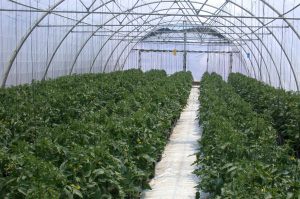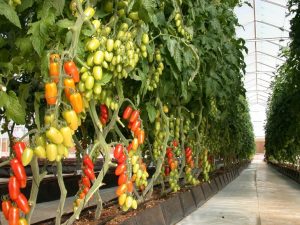Planting density plays an important role in the optimization of labor efficiency and productivity of your high tunnel. For the purpose of this article I will focus on tomato which is commonly grown as a high value crop on small farming operations.
Usually growers select varieties according to customer (market) preference and then try to combine that with other attributes such as ease of production, disease tolerance/resistance and productivity (yield). Consumer preference usually helps to determine the fruit color, size and shape, and the sweetness (soluble solids) of the tomato variety to be grown. The grower again is interested in earliness, growth habit (determinate and indeterminate), and ease of pruning, trellising and picking.
Most growers in Indiana choose determinate varieties for high tunnel production, because it has limited growth and is easy to stake and allows for early production (short production cycle), with most fruit ripening before field grown tomatoes are on the market. Indeterminate varieties continue to grow, flower and fruit throughout the production season. These varieties need to be pruned (either to single or double stem depending on the type and variety), trellised and layered, and most likely require the use of a higher tunnel as well. The yield potential of indeterminate varieties are higher than determinate varieties, but the production season is longer and it requires more labor to complete all the necessary crop husbandry activities.
The ability of a high tunnel to modify the growing environment for crop earliness, to protect the growing crop from environmental stress, to reduce insect and disease pressure and extend the growing and harvesting season, allows the grower to be at least 4 to 6 weeks earlier on the market (compared to field grown tomatoes) and maintain production of high quality fruit over a longer period. It increases marketing opportunities and improves early cash flow for the farming operation.
Variety selection, optimal plant spacing and production methods followed by the grower has an effect on the final outcome of the growing season. Proper spacing helps to achieve the greatest production possible. More plants in the high tunnel does not necessarily mean higher yield. A tunnel crowded with too many plants will restrict airflow which in turn may lead to the development of foliar and fruit diseases. Crowded plants compete for light, water and nutrients, and makes it difficult to maneuver through the crop to perform activities such as pruning, trellising, spraying and harvesting. Spacing includes the distance between rows and between plants in the row. Grafted plants are generally more vigorous and therefore need more spacing than none-grafted determinate or indeterminate varieties.
High tunnels can vary in size, with variability in width, length and height. High tunnels can also be equipped with different ventilation capabilities. Lower high tunnels will be warmer sooner during the day and very hot during the hottest part of summer. The height restriction in lower high tunnels will also prevent the optimal use of indeterminate varieties. Especially for summer production, it is beneficial to have more space between the crop and the glazing material as this will prevent scorching of leaves and fruit. Therefore the specifications of your high tunnel make or model will also play a crucial role in determining the variety to be grown, the planting density to be used and the ultimate productivity and return on investment. Production practices on your farm will also impact the optimum number of plants that can be grown and will determine how productive they can be. Let’s do some examples to illustrate the effect of planting density and the type of tomato crop planted on productivity and gross revenue.
Example 1: A determinate tomato crop is planted in soil in a 30’ × 96’ high tunnel (2,880 sq. ft.), allowing for a 3’ walkway at each end of the tunnel. The effective growing area of the tunnel therefore is only 2,700 sq. ft. Seedlings are planted in 6 rows, 5’ between rows and 18.3” in-row plant spacing. The total number of plants per row is 63 and per tunnel 378. Therefore the final planting density is 7.14 sq. ft. per plant. For illustrative purposes production is estimated at 14 lb per plant and is sold for $2.50 per lb, which translates into a gross revenue of $13,230.
If the planting density is adjusted to 6.25 sq. ft. per plant, with the same number of rows and in-row spacing decreasing to 16.0” (432 plants per tunnel), the gross revenue per tunnel will rise to $15,120. A slight increase in plant density from 7.14 to 6.25 sq. ft. per plant resulted in a gross revenue increase of about 14.3%. Data can vary widely between grower operations. In certain case studies done elsewhere in the U.S. determinate tomatoes yielded up to 20 lb per plant which will have a further increase in revenue.
Example 2: In the same tunnel footprint as above, indeterminate tomatoes can be planted in the soil at a planting density of up to 5.56 sq. ft. per plant. The in-row spacing therefore further decreased to 14.2”. The total number of plants per row is 81 and per tunnel 486. Production can reach between 20 and 25 lb per plant if grown for 8 months. At a 20 lb yield per plant and a market price of $ 2.50 per lb the potential gross revenue per tunnel can be $24,300.

Figure 2. Tomatoes planted in a double row at 4.3 plants per sq. ft. The soilless substrate is pine sawdust.
In soilless culture, using a growth substrate and hydroponics techniques and more advanced equipment to produce the tomatoes, the potential is there to produce even more tomatoes from one tunnel. In this instance you might be required to use a climate controlled greenhouse. Using the same footprint as above and increasing the plant density to 4.35 sq. ft. per plant allows us to plant 104 plants per row and 624 plants per tunnel. Production estimated at between 30 to 40 lb per plant can be achieved over 8 months of production. At a 30 lb yield per plant and a market price of $2.50 per lb the potential gross revenue per tunnel can be $46,800. This is a potential gross revenue increase of 92.6% compared to soil grown indeterminate tomatoes.

Figure 3. Round tomatoes planted in a single row at 4.3 plants per sq. ft. in coconut coir. Note the closer plant spacing in the row and wider walkways compared to the crop planted in sawdust (Figure 2).
From the scenarios created it is evident that by increasing the planting density you can potentially increase revenue. Indeterminate varieties, planted at a higher planting density than determinate varieties, can potentially earn the grower a higher income. However, soilless culture can potentially earn the grower even a higher income, when compared with soil production. Although, not discussed in this article is the associated higher cost of production between determinate and indeterminate varieties and between soil and soilless production techniques. The value of the increased yield does not always offset the cost of the increased labor required to take care of the additional plants. It is important to have well-kept production records to assist with decision making, to determine which crop and production technique works best for you. And remember, the customer (market) always determine what you do on your farm.
*The planting densities used in this article are not recommendations for Indiana. Further research is required.

